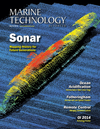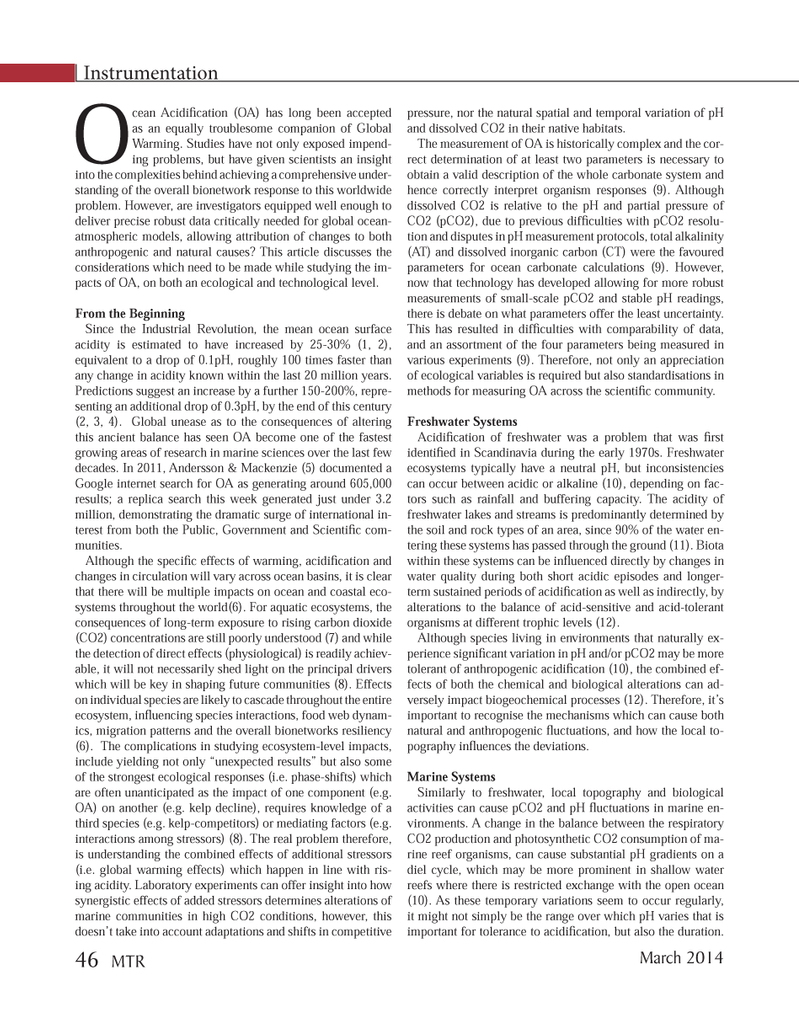
Page 46: of Marine Technology Magazine (March 2014)
Instrumentation: Measurement, Process & Analysis
Read this page in Pdf, Flash or Html5 edition of March 2014 Marine Technology Magazine
Ocean AcidiÞ cation (OA) has long been accepted as an equally troublesome companion of Global Warming. Studies have not only exposed impend- ing problems, but have given scientists an insight into the complexities behind achieving a comprehensive under- standing of the overall bionetwork response to this worldwide problem. However, are investigators equipped well enough to deliver precise robust data critically needed for global ocean- atmospheric models, allowing attribution of changes to both anthropogenic and natural causes? This article discusses the considerations which need to be made while studying the im-pacts of OA, on both an ecological and technological level. From the Beginning Since the Industrial Revolution, the mean ocean surface acidity is estimated to have increased by 25-30% (1, 2), equivalent to a drop of 0.1pH, roughly 100 times faster than any change in acidity known within the last 20 million years. Predictions suggest an increase by a further 150-200%, repre-senting an additional drop of 0.3pH, by the end of this century (2, 3, 4). Global unease as to the consequences of altering this ancient balance has seen OA become one of the fastest growing areas of research in marine sciences over the last few decades. In 2011, Andersson & Mackenzie (5) documented a Google internet search for OA as generating around 605,000 results; a replica search this week generated just under 3.2 million, demonstrating the dramatic surge of international in- terest from both the Public, Government and ScientiÞ c com- munities. Although the speciÞ c effects of warming, acidiÞ cation and changes in circulation will vary across ocean basins, it is clear that there will be multiple impacts on ocean and coastal eco-systems throughout the world(6). For aquatic ecosystems, the consequences of long-term exposure to rising carbon dioxide (CO2) concentrations are still poorly understood (7) and while the detection of direct effects (physiological) is readily achiev- able, it will not necessarily shed light on the principal drivers which will be key in shaping future communities (8). Effects on individual species are likely to cascade throughout the entire ecosystem, inß uencing species interactions, food web dynam- ics, migration patterns and the overall bionetworks resiliency (6). The complications in studying ecosystem-level impacts, include yielding not only Òunexpected resultsÓ but also some of the strongest ecological responses (i.e. phase-shifts) which are often unanticipated as the impact of one component (e.g. OA) on another (e.g. kelp decline), requires knowledge of a third species (e.g. kelp-competitors) or mediating factors (e.g. interactions among stressors) (8). The real problem therefore, is understanding the combined effects of additional stressors (i.e. global warming effects) which happen in line with ris- ing acidity. Laboratory experiments can offer insight into how synergistic effects of added stressors determines alterations of marine communities in high CO2 conditions, however, this doesnÕt take into account adaptations and shifts in competitive pressure, nor the natural spatial and temporal variation of pH and dissolved CO2 in their native habitats. The measurement of OA is historically complex and the cor- rect determination of at least two parameters is necessary to obtain a valid description of the whole carbonate system and hence correctly interpret organism responses (9). Although dissolved CO2 is relative to the pH and partial pressure of CO2 (pCO2), due to previous difÞ culties with pCO2 resolu- tion and disputes in pH measurement protocols, total alkalinity (AT) and dissolved inorganic carbon (CT) were the favoured parameters for ocean carbonate calculations (9). However, now that technology has developed allowing for more robust measurements of small-scale pCO2 and stable pH readings, there is debate on what parameters offer the least uncertainty. This has resulted in difÞ culties with comparability of data, and an assortment of the four parameters being measured in various experiments (9). Therefore, not only an appreciation of ecological variables is required but also standardisations in methods for measuring OA across the scientiÞ c community. Freshwater Systems AcidiÞ cation of freshwater was a problem that was Þ rst identiÞ ed in Scandinavia during the early 1970s. Freshwater ecosystems typically have a neutral pH, but inconsistencies can occur between acidic or alkaline (10), depending on fac- tors such as rainfall and buffering capacity. The acidity of freshwater lakes and streams is predominantly determined by the soil and rock types of an area, since 90% of the water en- tering these systems has passed through the ground (11). Biota within these systems can be inß uenced directly by changes in water quality during both short acidic episodes and longer- term sustained periods of acidiÞ cation as well as indirectly, by alterations to the balance of acid-sensitive and acid-tolerant organisms at different trophic levels (12). Although species living in environments that naturally ex- perience signiÞ cant variation in pH and/or pCO2 may be more tolerant of anthropogenic acidiÞ cation (10), the combined ef- fects of both the chemical and biological alterations can ad-versely impact biogeochemical processes (12). Therefore, itÕs important to recognise the mechanisms which can cause both natural and anthropogenic ß uctuations, and how the local to- pography inß uences the deviations. Marine SystemsSimilarly to freshwater, local topography and biological activities can cause pCO2 and pH ß uctuations in marine en- vironments. A change in the balance between the respiratory CO2 production and photosynthetic CO2 consumption of ma-rine reef organisms, can cause substantial pH gradients on a diel cycle, which may be more prominent in shallow water reefs where there is restricted exchange with the open ocean (10). As these temporary variations seem to occur regularly, it might not simply be the range over which pH varies that is important for tolerance to acidiÞ cation, but also the duration. Instrumentation March 2014 46 MTRMTR #2 (34-49).indd 46MTR #2 (34-49).indd 462/21/2014 11:13:53 AM2/21/2014 11:13:53 AM

 45
45

 47
47
